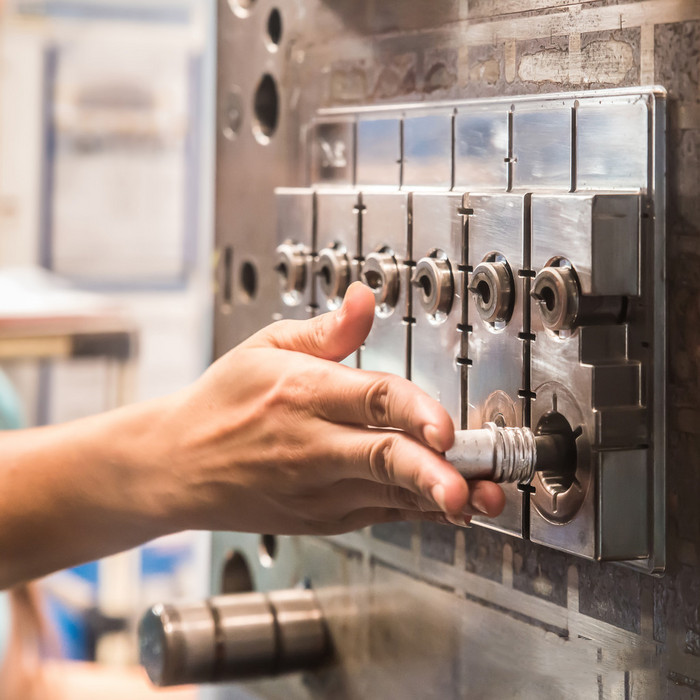
In industrial manufacturing, mold clamps are essential parts for injection molding machines to run in normal process. Not only are they used for mold clamping during the molding process, but also in mold change procedure. And the longer the time spent in mold changing, the lower productivity the company will get. Therefore, understand the basic features of 3 main types of mold clamping systems before deciding which type is the proper quick mold change solution for your machine.
Generally, molds can be fastened and changed through 3 mainly different clamping systems: mechanical(manual) mold clamping system, hydraulic mold clamping system and magnetic mold clamping system.
Mechanical(manual) mold clamping system: this is the oldest and simplest method, yet offers the lowest productivity, by using various kinds of components like bolts to clamp the mold manually.
Hydraulic mold clamping system: here comes the first question, what is hydraulic clamping?
Hydraulic clamping is the use of hydraulic system to position, support, and clamp parts for processing. The hydraulic system is made up of cylinders, pumps, valves, and other components to control the process.
Magnetic mold clamping system: clamping force generated by the magnets inside the magnetic clamping plates or platens. Magnetization and demagnetization of the platens, mold clamping and mold changing can all be operated through the control panel.
Mold Clamping System in Mechanical VS Hydraulic VS Magnetic Way
Features |
Traditional mold clamping system |
HVR MAG Magnetic mold clamping system |
|
Mechanical clamping |
Hydraulic clamping |
||
Reliability |
Serious potential safety hazard caused by bolts, screws and plates. |
No accurate reflection of clamping force on the plates; no signal indication of working status; clamping plates are easy to wear and tear and are occasionally unable to open for unloading the mod |
Real-time reflection of the clamping force of the plates and indication of the working status of the system; sending alarm signal to cease the running of machine before the mold operating improperly; insusceptible to power outage; no wearing part to be replaced |
Mold changeover efficiency |
High labor intensity; long mold change cycle. |
Long mold changing time with lower efficiency. |
Mold change time could be shortened within several minutes, more than 90% saved; one operator can do the job. |
Clamping position |
No clamping force at the centering area of the backside of mold, only available in limited peripheral mold positions, uneven clamping forces make the mold susceptible to deformations. |
The clamping force in each clamping position is inconsistent; no clamping force in the centering are of the backside of the mold – easy to deform. |
Uniform clamping over the entire mold; consistent clamping force in every clamping positions, helps avoid the possible deformation of the mold. |
Product quality |
Poor consistency of product quality due to uneven clamping force distributed. |
Poor consistency of product quality due to uneven clamping force distributed. |
Product quality ensured by the evenly distributed uniform clamping force generated by magnets. |
Mold adaptability |
Poor adaptability |
Poor adaptability – the fixed clamping position limitation requires the molds to be of the same specification. |
Great adaptability – no mold size limitations, even suitable for molds bigger than machine plate. |
Maintenance Costs |
Regular replacement of pressing plates and bolts, extremely high labor costs. |
Long working time of hydraulic pump leads to high energy consumption, frequent oil leakages, requiring manual cleaning. |
No energy consumption during the working process; only needs electricity in magnetization and demagnetization phase; no leakages, no cleaning required. |
To many molders, mold changeover is regarded as an extremely time-consuming and tricky job. Therefore, choosing the right, fast and safe mold clamping system in production can increase both injection mold availability and safety levels during mold changeover, and help avoid the negative impact that multiple mold changeovers have on productivity and the resulting increase in component costs.
The unique type of magnetic mold clamping system designed and manufactured by HVR MAG, is not only suitable for mold change process for injection molding machines, but also for die change for metal stamping press machines. Learn more about our mold change clamping system, welcome to our website.






